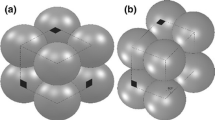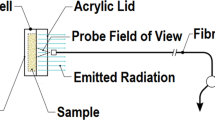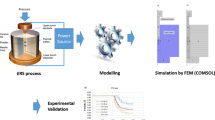Abstract
The objective of this study is to re-examine the classical parallel and classical series models of the effective thermal conductivity of porous media and review the underlying assumptions used to develop these asymptotic models. The Langmuir shape factor concept is introduced to gain insight into these classical models and add extra degrees of freedom to formulate semi-empirical correlations for the effective thermal conductivity based on the parallel, series, and combination of parallel and series heat flow configurations. The analytical models reveal the average areas of the heat flow as potential targets for curve fitting equations with fitting parameters. Experimental data for sintered porous copper were used to calibrate the theoretical models. Correlations for the effective thermal conductivity, Langmuir shape factors, average heat conduction areas, and the average lengths of the heat transfer pathway of the two phases as functions of porosity were obtained and compared graphically.














Similar content being viewed by others
Change history
16 April 2021
A Correction to this paper has been published: https://doi.org/10.1007/s00231-021-03064-3
Abbreviations
- A :
-
cross-sectional/contact area for heat flow, m2
- a :
-
fitting parameter
- k :
-
thermal conductivity, W/m-K
- L :
-
length of heat transfer pathway, m
- m :
-
fitting parameter
- n :
-
fitting parameter
- P :
-
porosity
- \( \dot{q} \) :
-
heat transfer rate, W
- R 2 :
-
coefficient of determination
- RMSE:
-
Root Mean Square Error
- S :
-
Langmuir shape factor, m
- ΔT :
-
temperature difference, K
- e:
-
effective
- f:
-
fluid-phase
- s:
-
solid-phase
- p :
-
parallel model
- s :
-
series model
- \( \overline{} \) :
-
normalized
References
Upadhyaya GS (2002) Powder metallurgy technology. Cambridge International Science Publishing, Cambridgeshire
Nakajima H (2013) Porous metals with directional pores. Springer, Japan, Tokyo
Ishizaki K, Komarneni S, Nanko M (1998) Porous materials: process technology and applications. Kluwer Academic Publishers, Dordrecht
Kaviany M (2001) Principles of heat transfer in porous media, 2nd edn. Springer, New York
Maxwell JC (1873) A Treatise on electricity and magnetism, vol 1. Clarendon Press, Oxford
Strutt J (1892) (Lord Rayleigh). On the influence of obstacles arranged in rectangular order upon the properties of a medium. Philosophical Magazine 34(211):481–502
Eucken A (1940) Allgemeine gesetzmäßigkeiten für das wärmeleitvermögen verschiedener stoffarten und aggregatzustände. Forschung auf dem Gebiete des Ingenieurwesens 11(1):6–20
Russell HW (1935) Principles of heat flow in porous insulators. J Am Ceramic Society 18(1):1–5
Ranut P (2016) On the effective thermal conductivity of aluminum metal foams: Review and improvement of the available empirical and analytical models. Appl Therm Eng 101:496–524
Pietrak K, Wi’sniewsk TS (2015) A review of models for effective thermal conductivity of composite materials. J Power Technol 95(1):14–24
Hasselman DPH, Johnson LF (1987) Effective thermal conductivity of composites with interfacial thermal barrier resistance. J Compos Mater 21(6):508
Benveniste Y, Miloh T (1986) The effective conductivity of composites with imperfect thermal contact at constituent interfaces. Int J Eng Sci 24(9):1537
Benveniste Y (1987) Effective thermal conductivity of composites with a thermal contact resistance between the constituents: Nondilute case. J Appl Phys 61(8):2840
Randrianalisoa J, Baillis D, Martin CL, Dendievel R (2015) Microstructure effects on thermal conductivity of open-cell foams generated from the Laguerre-Voronoï tessellation method. Int J Therm Sci 98:277–286
Sumirat I, Ando Y, Shimamura S (2006) Theoretical consideration of the effect of porosity on thermal conductivity of porous materials. J Porous Mater 13:439–443
Askari R, Taheri R, Taheri S, Hejazi H (2015) Thermal conductivity of granular porous media: A pore-scale modeling approach. AIP Adv 5:097106
Skibinski J, Cwieka K, Ibrahim SH, Wejrzanowski T (2019) Influence of pore size variation on thermal conductivity of open-porous foams. Materials 12:2017
Krischer O (1963) Die wissenschaftlichen Grundlagen der Trocknungstechnik (The scientific fundamentals of drying technology). Springer-Verlag, Berlin
Carson JK (2006) Review of effective thermal conductivity models for foods. Int J Refriger 29(6):958–967
Sunden B, Yuan J (2013) Evaluation of models of the effective thermal conductivity of porous materials relevant to fuel cell electrode. Int J Comp Meth Exp Meas 1(4):440–455
Sadeghi E (2010) Thermal transport in porous media with application to fuel cell diffusion media and metal foams. Ph.D. Thesis, Mechanical Engineering, University of Victoria, Canada
Tsao GTN (1961) Thermal conductivity of two-phase materials. Industr Eng Chem 53(5):395–297
Dul'nev GN (1965) Heat transfer through solid disperse systems. J Eng Phys 9(3):275–279
Singh KJ, Singh R, Chaudhary DR (1998) Heat conduction and a porosity correction term for spherical and cubic particles in a simple cubic packing. J Phys D Appl Phys 31:1681–1687
Calmidi VV, Mahajan RL (1999) The effective thermal conductivity of high porosity fibrous metal foams. Transactions of the ASME. J Heat Transfer 121:466–471
Gong L, Wang Y, Cheng X, Zhang R, Zhang H (2014) A novel effective medium theory for modelling the thermal conductivity of porous materials. Int J Heat Mass Transfer 68:295–298
Smith JC, Lind JE Jr, Lermond DS (1958) Factors for conductive heat flow. A1ChE J 4:330–331
Nickolay M, Fischer L, Martin H (1998) Shape factors for conductive heat flow circular and quadratic cross-sections. Int J Heat Mass Transfer 41(11):1437–1444
Yang X, Lu T, Kim T (2013) Effective thermal conductivity modelling for closed-cell porous media with analytical shape factors. Transport Porous Media 100:211–224
Koh, JCY, Fortini, A. Thermal conductivity and electrical resistivity of porous material. Technical Report (1971)
Pinkerton CC, Jr. Experimental determination of the thermal conductivity of porous copper. Thesis, Aeronautical Engineering, California Institute of Technology, (1948)
Xiao Z. Heat Transfer, Fluid transport and mechanical properties of porous copper manufactured by lost carbonate sintering. Ph.D. Thesis, The University of Liverpool, UK (2013)
Engineering Equation Solver (EES), F-chart Software, (2019). http://fchartsoftware.com/ees/
Acknowledgments
We gratefully acknowledge the support of Kuwait University.
Data availability statement
The datasets generated or analyzed during the current study are available from the corresponding author on reasonable request.
Author information
Authors and Affiliations
Contributions
Conceptualization, Methodology, Analysis, Writing-Original Draft by O.M. Ibrahim, and A.H. Al-Saiafi. Validation, Writing-Review, and Editing by O.M. Ibrahim and S. Alotaibi. The autho(s) read and approved the final manuscript.
Corresponding author
Ethics declarations
Conflict of interest
The authors declare no conflict of interest.
Additional information
Publisher’s note
Springer Nature remains neutral with regard to jurisdictional claims in published maps and institutional affiliations.
The original version of this article was revised: typographical errors were corrected throughout the chapter.
Appendices
Appendix A
1.1 Experimental data
Appendix B
1.1 Equation Summary of the classical and re-examined models
Rights and permissions
About this article
Cite this article
Ibrahim, O.M., Al-Saiafi, A.H. & Alotaibi, S. Thermal conductivity of porous sintered metal powder and the Langmuir shape factor. Heat Mass Transfer 57, 1289–1304 (2021). https://doi.org/10.1007/s00231-021-03032-x
Received:
Accepted:
Published:
Issue Date:
DOI: https://doi.org/10.1007/s00231-021-03032-x




